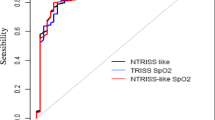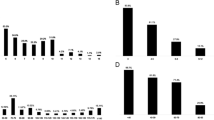Abstract
Background
We aimed to study the value of new physiological variables compared with ISS and GCS as predictors for trauma mortality in a high-income developing country having a young population.
Methods
Data of 1008 consecutive trauma patients who were included in Al-Ain City Road Traffic Collision Registry were analyzed. Demography of patients, systolic blood pressure, heart rate, shock index, shock index age (SIA), blood pressure age index (BPAI), Glasgow Coma Scale (GCS), injury severity score (ISS), and in-hospital mortality were analyzed. Univariate analysis was used to compare those who died with those who survived. Significant factors were then entered into a backward logistic regression model to define factors predicting mortality.
Results
80.3% of the patients were males. The median (range) age of patients was 26 (1–78) years. Significant factors that predicted mortality were GCS (p < 0.0001), SIA (p = 0.003), ISS (p = 0.007), and BPAI (p = 0.022).
Conclusions
The physiological variables including GCS and shock index age were better predictors for trauma mortality comparted with ISS in our young population. A large global multi-centric study could possibly define an accurate global formula that uses both anatomical and physiological variables for predicting trauma mortality.


Similar content being viewed by others
Abbreviations
- BPAI:
-
Blood pressure age index
- MP:
-
Minute pulse
- MSI:
-
Modified shock index
- PMI:
-
Pulse maximum index
- ROPE:
-
Rate over pulse pressure evaluation index
- SI:
-
Shock index
- SIA:
-
Shock index age
References
Lozano R, Naghavi M, Foreman K, et al. Global and regional mortality from 235 causes of death for 20 age groups in 1990 and 2010: a systematic analysis for the Global Burden of Disease Study 2010. Lancet. 2013;380:2095–128.
Haagsma JA, Graetz N, Bolliger I, et al. The global burden of injury: incidence, mortality, disability-adjusted life years and time trends from the Global Burden of Disease study 2013. Inj Prev. 2016;22:3–18.
American College of Surgeons. Advanced trauma life support for doctors. 9th ed. Chicago: American College of Surgeons; 2012.
Eid HO, Barss P, Adam SH, et al. Factors affecting anatomical region of injury, severity, and mortality for road trauma in a high-income developing country: lessons for prevention. Injury. 2009;40:703–7.
Reith FC, Van den Brande R, Synnot A, Gruen R, Maas AI. The reliability of the Glasgow Coma Scale: a systematic review. Intensive Care Med. 2016;42:3–15.
Smith IM, Naumann DN, Guyver P, et al. Interobserver variability in injury severity scoring after combat trauma: different perspectives, different values? J Spec Oper Med. 2015;15:86–93.
Matthes G, Schmucker U, Frank M, et al. Assessment of injury severity at the accident scene by the emergency physician: utility of technical crash parameters: results of a pilot study. Der Unfallchirurg. 2013;116:825–30.
Cannon CM, Braxton CC, Kling-Smith M, et al. Utility of the shock index in predicting mortality in traumatically injured patients. J Trauma Acute Care Surg. 2009;67:1426–30.
Campbell R, Ardagh MW, Than M. Validation of the pulse rate over pressure evaluation index as a detector of early occult hemorrhage: a prospective observational study. J Trauma Acute Care Surg. 2012;73:286–8.
Vandromme MJ, Griffin RL, Kerby JD, et al. Identifying risk for massive transfusion in the relatively normotensive patient: utility of the prehospital shock index. J Trauma. 2011;70:384–8.
Bruijns SR, Guly HR, Bouamra O, et al. The value of traditional vital signs, shock index, and age-based markers in predicting trauma mortality. J Trauma Acute Care Surg. 2013;74:1432–7.
Shaban S, Eid HO, Barka E, Abu-Zidan FM. Towards a national trauma registry for the United Arab Emirates. BMC Res Notes. 2010;3:187.
Liu Y, Fang ZA, Shan G, et al. Modified shock index and mortality rate of emergency patients. World J Emerg Med. 2012;3:114–7.
Singh A, Ali S, Agarwal A, Srivastava RN. Correlation of shock index and modified shock index with the outcome of adult trauma patients: a prospective study of 9860 patients. N Am J Med Sci. 2014;6:450–2.
Kim SY, Hong KJ, Shin SD, et al. Validation of the shock index, modified shock index, and age shock index for predicting mortality of geriatric trauma patients in emergency departments. J Korean Med Sci. 2016;31:2026–32.
Kuhls DA, Malone DL, McCarter RJ, et al. Predictors of mortality in adult trauma patients: the physiologic trauma score is equivalent to the trauma and injury severity score. J Am Coll Surg. 2002;194:695–704.
Abu-Zidan FM, Abbas AK, Hefny AF, et al. Effects of seat belt usage on injury pattern and outcome of vehicle occupants after road traffic collisions: prospective study. World J Surg. 2012;36:255–9.
Eid HO, Abu-Zidan FM. Biomechanics of road traffic collision injuries: a clinician’s perspective. Singap Med J. 2007;48:693.
Author information
Authors and Affiliations
Corresponding author
Ethics declarations
Conflict of interest
Arif Alper Cevik and Fikri Abu-Zidan declare that they have no conflict of interest.
Research involving human participants
Data collection of the registry was approved by the Local Ethics Committee of the Health District of Al-Ain city and met the standards outlined in the Declaration of Helsinki.
Informed consent
All patients or their caregivers signed a consent form giving permission to use their anonymous data for research.
Funding
This study was supported by an Interdisciplinary UAE University Grant (no. 02-07-8-1/4).
Rights and permissions
About this article
Cite this article
Cevik, A.A., Abu-Zidan, F.M. Searching for mortality predictors in trauma patients: a challenging task. Eur J Trauma Emerg Surg 44, 561–565 (2018). https://doi.org/10.1007/s00068-017-0830-6
Received:
Accepted:
Published:
Issue Date:
DOI: https://doi.org/10.1007/s00068-017-0830-6




